Characteristics of Swell-like Waves in the East Coast of Korea Using Atmospheric and Wave Hindcast Data
Abstract
:1. Introduction
2. Data and Method
2.1. Data
2.2. Model for Atmospheric and Wave Hindcast
2.3. Identification and Tracking of ETCs
2.4. Wind Activity Index
3. Results
3.1. Characteristics of Swell-like Waves on the East Coast of Korea
3.2. Model Assessment of 10 m Wind and Wave
3.3. Decadal Trends of Swell-like Waves
4. Discussion
5. Conclusions
Author Contributions
Funding
Institutional Review Board Statement
Informed Consent Statement
Data Availability Statement
Acknowledgments
Conflicts of Interest
References
- Kitaide, M. On the mechanism and forecasting of the so-called “Yorimawari” Wave. Mar. Rep. Cent. Meteorol. Obs. 1952, 2, 125–151. [Google Scholar]
- Joung, C.H.; Kim, S.S.; Park, S.U.; Min, K.D.; An, H.S. A case study on the extratropical cyclone development on the East Sea. J. Korean Met. Soc. 1984, 20, 1–21. [Google Scholar]
- Lee, H.S.; Kim, K.O.; Yamashita, T.; Komaguchi, T.; Mishima, T. Abnormal storm waves in the winter East/Japan Sea: Generation process and hindcasting using an atmosphere-wind wave modelling system. Nat. Hazards Earth Syst. Sci. 2010, 10, 773–792. [Google Scholar] [CrossRef]
- Heo, K.Y.; Choi, J.Y.; Jeong, S.H.; Kwon, J.I. Characteristics of High Swell-like Waves on East Coast of Korea Observed by Direct Measurements and Reanalysis Data Sets. J. Coast. Res. 2020, 95, 1433–1437. [Google Scholar] [CrossRef]
- Pierson, W.J., Jr.; Moskowitz, L. A proposed spectral form for fully developed wind seas based on the similarity theory of SA Kitaigorodskii. J. Geophys. Res. 1964, 69, 5181–5190. [Google Scholar] [CrossRef]
- Collard, F.; Ardhuin, F.; Chapron, B. Monitoring and analysis of ocean swell fields from space: New methods for routine observations. J. Geophys. Res. Earth Surf. 2009, 114, C07023. [Google Scholar] [CrossRef] [Green Version]
- Dobson, F.; Perrie, W.; Toulany, B. On the deep-water fetch laws for wind-generated surface gravity waves. Atmos. Ocean 1989, 27, 210–236. [Google Scholar] [CrossRef]
- Ebuchi, N.; Kawamura, H.; Toba, Y. Growth of Wind-Waves with Fetch Observed by the Geosat Altimeter in the Japan Sea under Winter Monsoon. J Geophys. Res. Oceans 1992, 97, 809–819. [Google Scholar] [CrossRef]
- Utsunomiya, Y.; Okada, H.; Eguchi, I.; Takayama, T.; Nihei, F. A study on the prediction and monitoring system of swell waves. Coast. Res. Cent. 2009, 9, 81–84. [Google Scholar]
- Jeong, W.M.; Oh, S.H.; Lee, D.Y. Abnormally high waves on the east coast. J. Korean Soc. Coast. Ocean Eng. 2007, 19, 295–302. [Google Scholar]
- Oh, S.H.; Jeong, W.M.; Lee, D.Y.; Kim, S.I. Analysis of the reason for occurrence of large-height swell-like waves in the east coast of Korea. J. Korean Soc. Coast. Ocean Eng. 2010, 22, 101–111. [Google Scholar]
- Geosystem Research. Investigation of Large Swell Waves and Rip Currents and Development of the Disaster Response System (Publification No. 2014-0057); Ministry of Oceans and Fisheries: Sejong, Korea, 2019; pp. 116–122.
- Jang, J.B.; Yeo, Y.K.; Lee, J.K.; Park, K.S. The analysis and cause tracking method for the swell-generated waves in Korea. In Proceedings of the 2008 Conference of the Korean Association of Ocean Science and Technology Societies, Jeju, Korea, 29 May 2008; pp. 2448–2451. [Google Scholar]
- Chen, S.J.; Kuo, Y.H.; Zhang, P.Z.; Bai, Q.F. Climatology of Explosive Cyclones Off the East-Asian Coast. Mon. Weather Rev. 1992, 120, 3029–3035. [Google Scholar] [CrossRef]
- Ninomiya, J.; Taka, Y.; Mori, N. Projecting changes in explosive cyclones and high waves around Japan using a mega-ensemble projection. Ocean Eng. 2021, 237, 109634. [Google Scholar] [CrossRef]
- Heo, K.Y.; Shim, J.S.; Kwon, J.I.; Jeong, J.Y.; Park, K.S.; Choi, J.W. Abnormal storm waves around the Korean Peninsula: A case study of an extratropical explosive cyclone over East Sea. J. Coast. Res. 2013, 65, 720–725. [Google Scholar] [CrossRef]
- Jeong, W.M.; Oh, S.H. Abnormally High Swells Occurred on the East Coast in Recent Several Years. In Proceedings of the 2009 Conference of the Korean Association of Ocean Science and Technology Societies, Changwon, Korea, 28 May 2009; pp. 2119–2122. [Google Scholar]
- Chang, E.K.M.; Lee, S.Y.; Swanson, K.L. Storm track dynamics. J. Clim. 2002, 15, 2163–2183. [Google Scholar] [CrossRef] [Green Version]
- Hoskins, B.J.; Hodges, K.I. New perspectives on the Northern Hemisphere winter storm tracks. J. Atmos. Sci. 2002, 59, 1041–1061. [Google Scholar] [CrossRef]
- Madonna, E.; Wernli, H.; Joos, H.; Martius, O. Warm Conveyor Belts in the ERA-Interim Dataset (1979–2010). Part I: Climatology and Potential Vorticity Evolution. J. Clim. 2014, 27, 3–26. [Google Scholar] [CrossRef] [Green Version]
- Dee, D.P.; Uppala, S.M.; Simmons, A.J.; Berrisford, P.; Poli, P.; Kobayashi, S.; Andrae, U.; Balmaseda, M.A.; Balsamo, G.; Bauer, P.; et al. The ERA-Interim reanalysis: Configuration and performance of the data assimilation system. Q. J. R. Meteorol. Soc 2011, 137, 553–597. [Google Scholar] [CrossRef]
- Skamarock, W.C.; Klemp, J.B.; Dudhia, J.; Gill, D.O.; Barker, D.M.; Wang, W.; Powers, J.G. A Description of the Advanced Research WRF Version 3. NCAR Technical Note-475+ STR; University Corporation for Atmospheric Research: Boulder, CO, USA, 2008. [Google Scholar]
- Huang, X. Four-dimensional variational data assimilation for WRF: Formulation and preliminary results. Mon. Weather Rev. 2009, 137, 299–314. [Google Scholar] [CrossRef] [Green Version]
- Barker, D.M. The Weather Research and Forecasting Model’s Community Variational/Ensemble Data Assimilation System: WRFDA. Bull. Am. Meteorol. Soc. 2012, 93, 831–843. [Google Scholar] [CrossRef] [Green Version]
- Hong, S.Y.; Noh, Y.; Dudhia, J. A new vertical diffusion package with an explicit treatment of entrainment processes. Mon. Weather Rev. 2006, 134, 2318–2341. [Google Scholar] [CrossRef] [Green Version]
- Niu, G.Y.; Yang, Z.L.; Mitchell, K.E.; Chen, F.; Ek, M.B.; Barlage, M.; Kumar, A.; Manning, K.; Niyogi, D.; Rosero, E. The community Noah land surface model with multiparameterization options (Noah-MP): 1. Model description and evaluation with local-scale measurements. J. Geophys. Res. Atmos. 2011, 116, D12109. [Google Scholar] [CrossRef] [Green Version]
- Kain, J.S.; Fritsch, J.M. Convective Parameterization for Mesoscale Models: The Kain-Fritsch Scheme. In The Representation of Cumulus Convection in Numerical Models; Emanuel, K.A., Raymond, D.J., Eds.; American Meteorological Society: Boston, MA, USA, 1993; pp. 165–170. [Google Scholar]
- Dudhia, J. Numerical Study of Convection Observed during the Winter Monsoon Experiment Using a Mesoscale Two-Dimensional Model. J. Atmos. Sci. 1989, 46, 3077–3107. [Google Scholar] [CrossRef]
- Hong, S.Y.; Lim, J.O.J. The WRF single-moment 6-class microphysics scheme (WSM6). Asia-Pac. J. Atmos. Sci. 2006, 42, 129–151. [Google Scholar]
- Booij, N.; Ris, R.C.; Holthuijsen, L.H. A third-generation wave model for coastal regions: 1. Model description and validation. J. Geophys. Res. Oceans 1999, 104, 7649–7666. [Google Scholar] [CrossRef] [Green Version]
- Intergovernmental Oceanographic Commission (IOC). BODC: Centenary Edition of the GEBCO Digital Atlas [CD-ROM]; British Oceanographic Data Centre: Liverpool, UK, 2003. [Google Scholar]
- Hasselmann, K.F.; Barnett, T.P.; Bouws, E.; Carlson, H.; Cartwright, D.E.; Eake, K.; Euring, J.; Gicnapp, A.; Hasselmann, D.; Kruseman, P. Measurements of wind-wave growth and swell decay during the Joint North Sea Wave Project (JONSWAP). Ergaenzungsh. Dtsch. Hydrogr. Z. 1973, 8, 1–95. [Google Scholar]
- Flaounas, E.; Kotroni, V.; Lagouvardos, K.; Flaounas, I. CycloTRACK (v1.0)—Tracking winter extratropical cyclones based on relative vorticity: Sensitivity to data filtering and other relevant parameters. Geosci. Model Dev. 2014, 7, 1841–1853. [Google Scholar] [CrossRef] [Green Version]
- Lu, C.H. A Modified Algorithm for Identifying and Tracking Extratropical Cyclones. Adv. Atmos. Sci. 2017, 34, 909–924. [Google Scholar] [CrossRef]
- Grise, K.M.; Son, S.W.; Gyakum, J.R. Intraseasonal and Interannual Variability in North American Storm Tracks and Its Relationship to Equatorial Pacific Variability. Mon. Weather Rev. 2013, 141, 3610–3625. [Google Scholar] [CrossRef] [Green Version]
- Ren, H.L.; Jin, F.F.; Kug, J.S.; Zhao, J.X.; Park, J. A kinematic mechanism for positive feedback between synoptic eddies and NAO. Geophys. Res. Lett. 2009, 36, L11709. [Google Scholar] [CrossRef] [Green Version]
- O’Reilly, C.H.; Minobe, S.; Kuwano-Yoshida, A. The influence of the Gulf Stream on wintertime European blocking. Clim. Dyn. 2015, 47, 1545–1567. [Google Scholar] [CrossRef] [Green Version]
- Willmott, C.J. On the validation of models. Phys. Geogr. 1981, 2, 184–194. [Google Scholar] [CrossRef]
- Willmott, C.J. Some comments on the evaluation of model performance. Bull. Am. Meteorol. Soc. 1982, 63, 1309–1313. [Google Scholar] [CrossRef] [Green Version]
- Kundu, P.K. Ekman veering observed near the ocean bottom. J. Phys. Oceanogr. 1976, 6, 238–242. [Google Scholar] [CrossRef]
- Kim, H.J.; Heo, K.Y.; Kim, N.H.; Kwon, J.I. Hindcasts of Sea Surface Wind around the Korean Peninsula Using the WRF Model: Added Value Evaluation and Estimation of Extreme Wind Speeds. Atmosphere 2021, 12, 895. [Google Scholar] [CrossRef]
- Chung, Y.S.; Hage, K.D.; Reinelt, E.R. On lee cyclogenesis and airflow in the Canadian Rocky Mountains and the East Asian Mountains. Mon. Weather Rev. 1976, 104, 879–891. [Google Scholar] [CrossRef] [Green Version]
- Whittaker, L.; Horn, L. Northern Hemisphere extratropical cyclone activity for four mid-season months. J. Climatol. 1984, 4, 297–310. [Google Scholar] [CrossRef]
- Chen, S.J.; Kuo, Y.H.; Zhang, P.Z.; Bai, Q.F. Synoptic Climatology of Cyclogenesis over East-Asia, 1958–1987. Mon. Weather Rev. 1991, 119, 1407–1418. [Google Scholar] [CrossRef] [Green Version]
- Adachi, S.; Kimura, F. A 36-year climatology of surface cyclogenesis in East Asia using high-resolution reanalysis data. Sola 2007, 3, 113–116. [Google Scholar] [CrossRef] [Green Version]
- Zhang, Y.X.; Ding, Y.H.; Li, Q.P. A Climatology of Extratropical Cyclones over East Asia During 1958–2001. Acta Meteorol. Sin. 2012, 26, 261–277. [Google Scholar] [CrossRef]
- Chen, L.; Tan, B.K.; Kvamsto, N.G.; Johannessen, O.M. Wintertime cyclone/anticyclone activity over China and its relation to upper tropospheric jets. Tellus A Dyn. Meteorol. Oceanogr. 2014, 66, 21889. [Google Scholar] [CrossRef] [Green Version]
- Wang, X.M.; Zhai, P.M.; Wang, C.C. Variations in extratropical cyclone activity in northern East Asia. Adv. Atmos. Sci. 2009, 26, 471–479. [Google Scholar] [CrossRef]
- Lee, J.; Son, S.W.; Cho, H.O.; Kim, J.; Cha, D.H.; Gyakum, J.R.; Chen, D. Extratropical cyclones over East Asia: Climatology, seasonal cycle, and long-term trend. Clim. Dyn. 2019, 54, 1131–1144. [Google Scholar] [CrossRef]
- Seo, K.H.; Son, J.H.; Lee, J.Y.; Park, H.S. Northern East Asian monsoon precipitation revealed by air mass variability and its prediction. J. Clim. 2015, 28, 6221–6233. [Google Scholar] [CrossRef]
- Wirth, V.; Riemer, M.; Chang, E.K.M.; Martius, O. Rossby Wave Packets on the Midlatitude Waveguide—A Review. Mon. Weather Rev. 2018, 146, 1965–2001. [Google Scholar] [CrossRef]
- Sampe, T.; Nakamura, H.; Goto, A.; Ohfuchi, W. Significance of a midlatitude SST frontal zone in the formation of a storm track and an eddy-driven westerly jet. J. Clim. 2010, 23, 1793–1814. [Google Scholar] [CrossRef]
- Holton, J. An Introduction to Dynamic Meteorology, 2nd ed.; International Geophysics Series; Academic Press: New York, NY, USA, 1979; Volume 23. [Google Scholar]
- Semedo, A.; Vettor, R.; Breivik, Ø.; Sterl, A.; Reistad, M.; Soares, C.G.; Lima, D. The wind sea and swell waves climate in the Nordic seas. Ocean Dyn. 2015, 65, 223–240. [Google Scholar] [CrossRef]
- Christakos, K.; Varlas, G.; Cheliotis, I.; Spyrou, C.; Aarnes, O.J.; Furevik, B.R. Characterization of wind-sea-and swell-induced wave energy along the Norwegian coast. Atmosphere 2020, 11, 166. [Google Scholar] [CrossRef] [Green Version]
- Ardhuin, F.; Roland, A.; Dumas, F.; Bennis, A.-C.; Sentchev, A.; Forget, P.; Wolf, J.; Girard, F.; Osuna, P.; Benoit, M. Numerical wave modeling in conditions with strong currents: Dissipation, refraction, and relative wind. J. Phys. Oceanogr. 2012, 42, 2101–2120. [Google Scholar] [CrossRef]
- Ardhuin, F.; Gille, S.T.; Menemenlis, D.; Rocha, C.B.; Rascle, N.; Chapron, B.; Gula, J.; Molemaker, J. Small-scale open ocean currents have large effects on wind wave heights. J. Geophys. Res. Oceans 2017, 122, 4500–4517. [Google Scholar] [CrossRef] [Green Version]
- Onorato, M.; Proment, D.; Toffoli, A. Triggering rogue waves in opposing currents. Phys. Rev. Lett. 2011, 107, 184502. [Google Scholar] [CrossRef] [PubMed]
- Christakos, K.; Björkqvist, J.-V.; Breivik, Ø.; Tuomi, L.; Furevik, B.R.; Albretsen, J. The impact of surface currents on the wave climate in narrow fjords. Ocean Model. 2021, 168, 101894. [Google Scholar] [CrossRef]
- Van der Westhuysen, A.J.; Zijlema, M.; Battjes, J.A. Nonlinear saturation-based whitecapping dissipation in SWAN for deep and shallow water. Coast. Eng. 2007, 54, 151–170. [Google Scholar] [CrossRef]
- Christakos, K.; Björkqvist, J.-V.; Tuomi, L.; Furevik, B.R.; Breivik, Ø. Modelling wave growth in narrow fetch geometries: The white-capping and wind input formulations. Ocean Model. 2021, 157, 101730. [Google Scholar] [CrossRef]
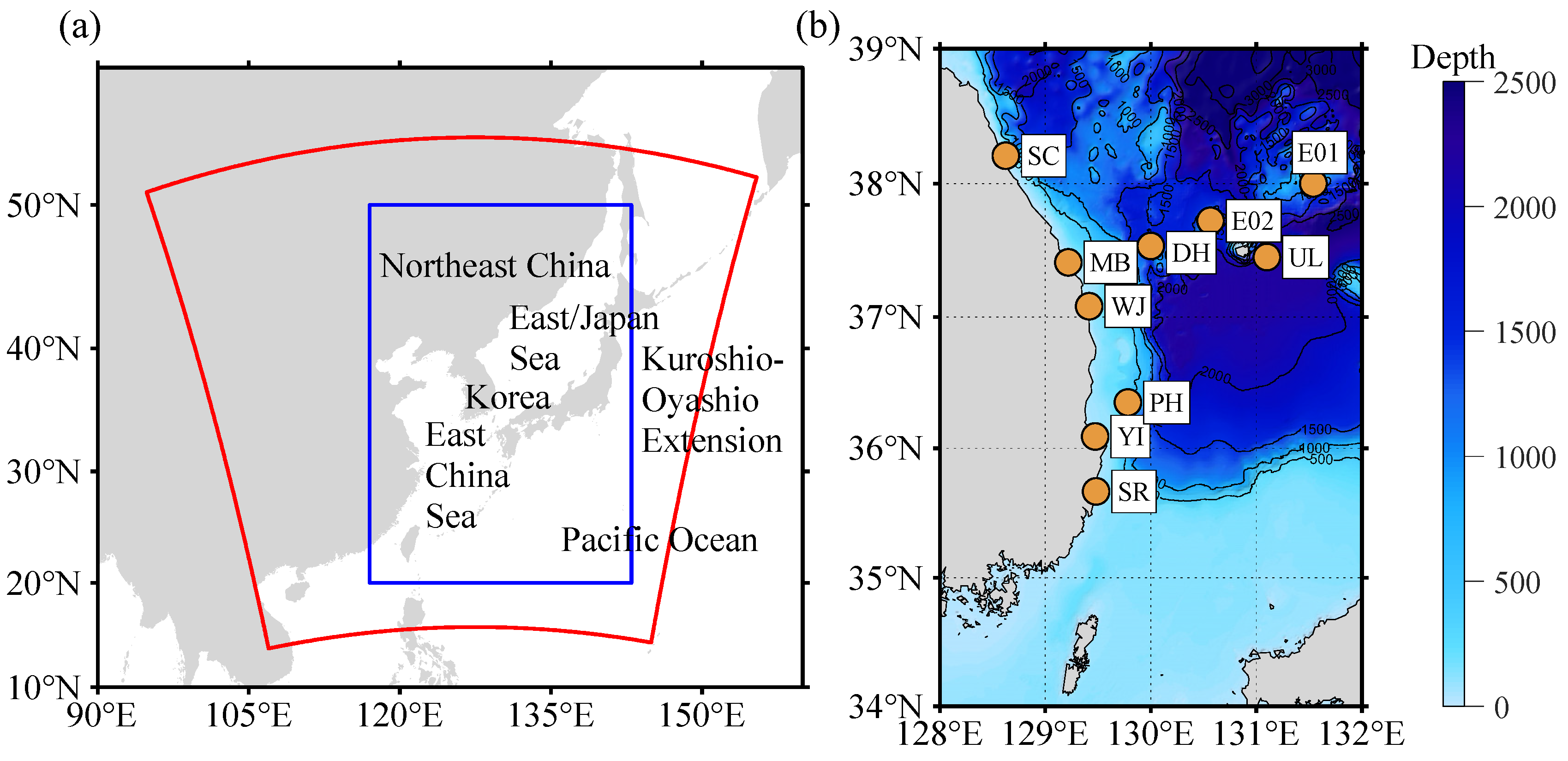
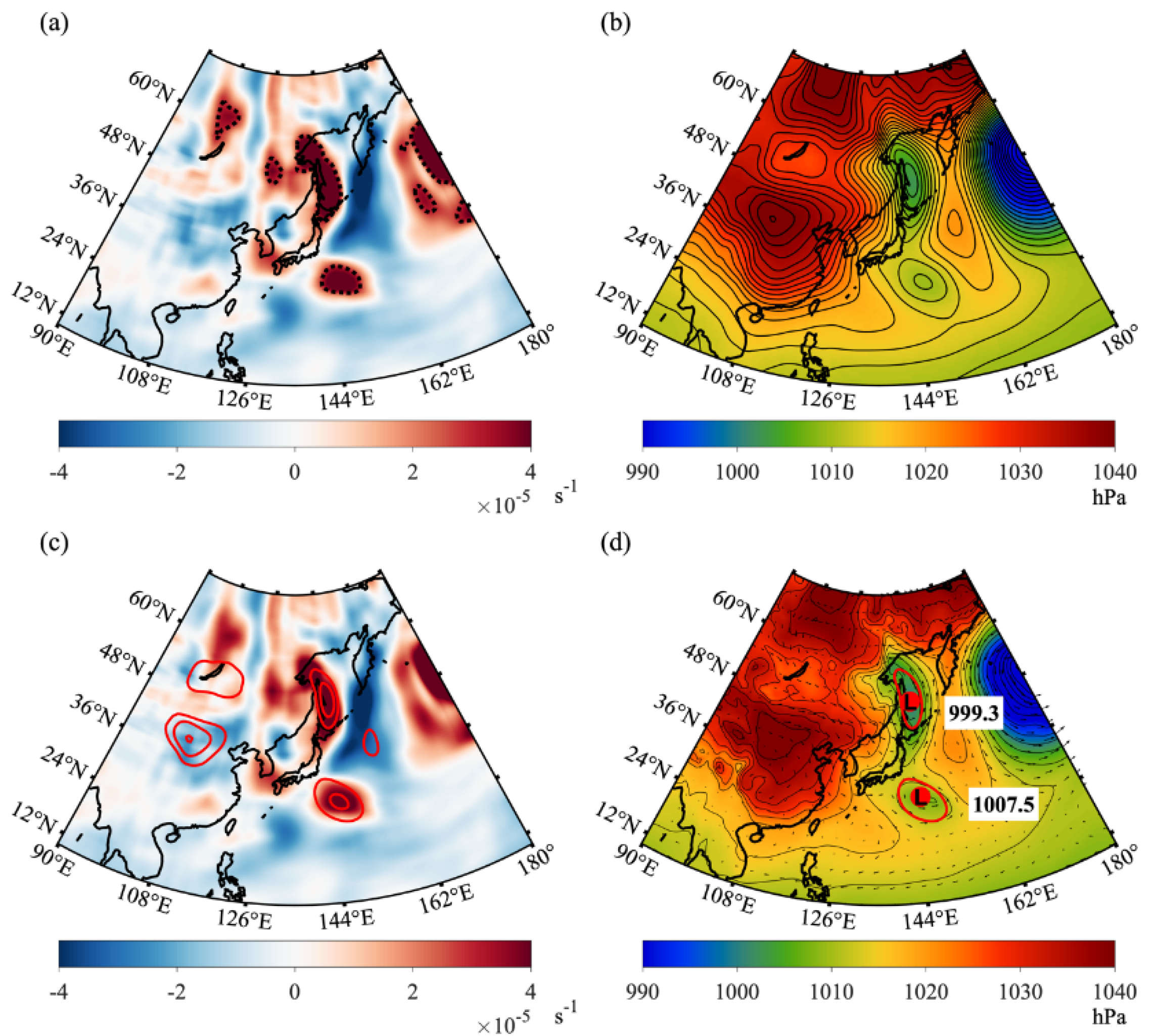
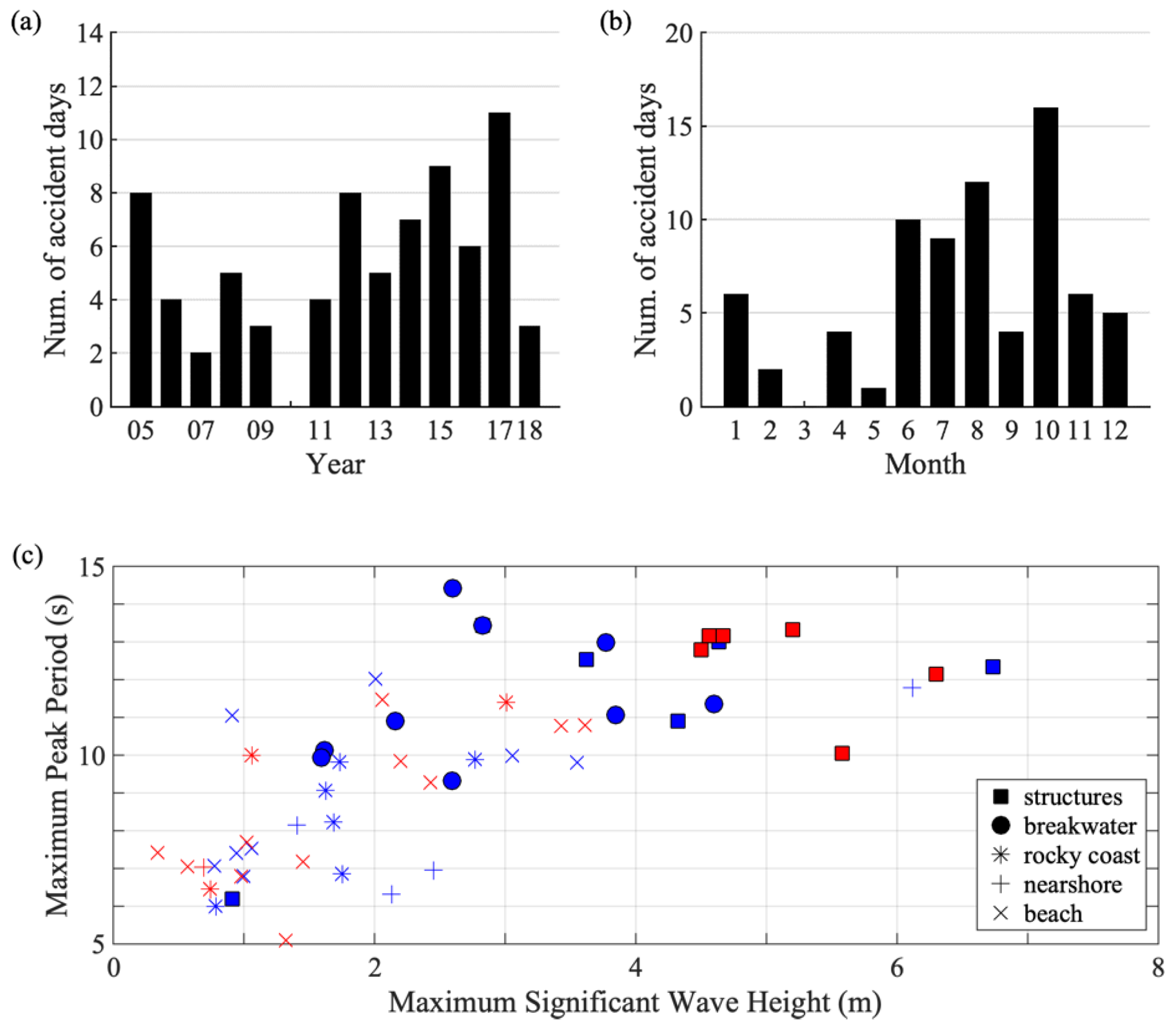
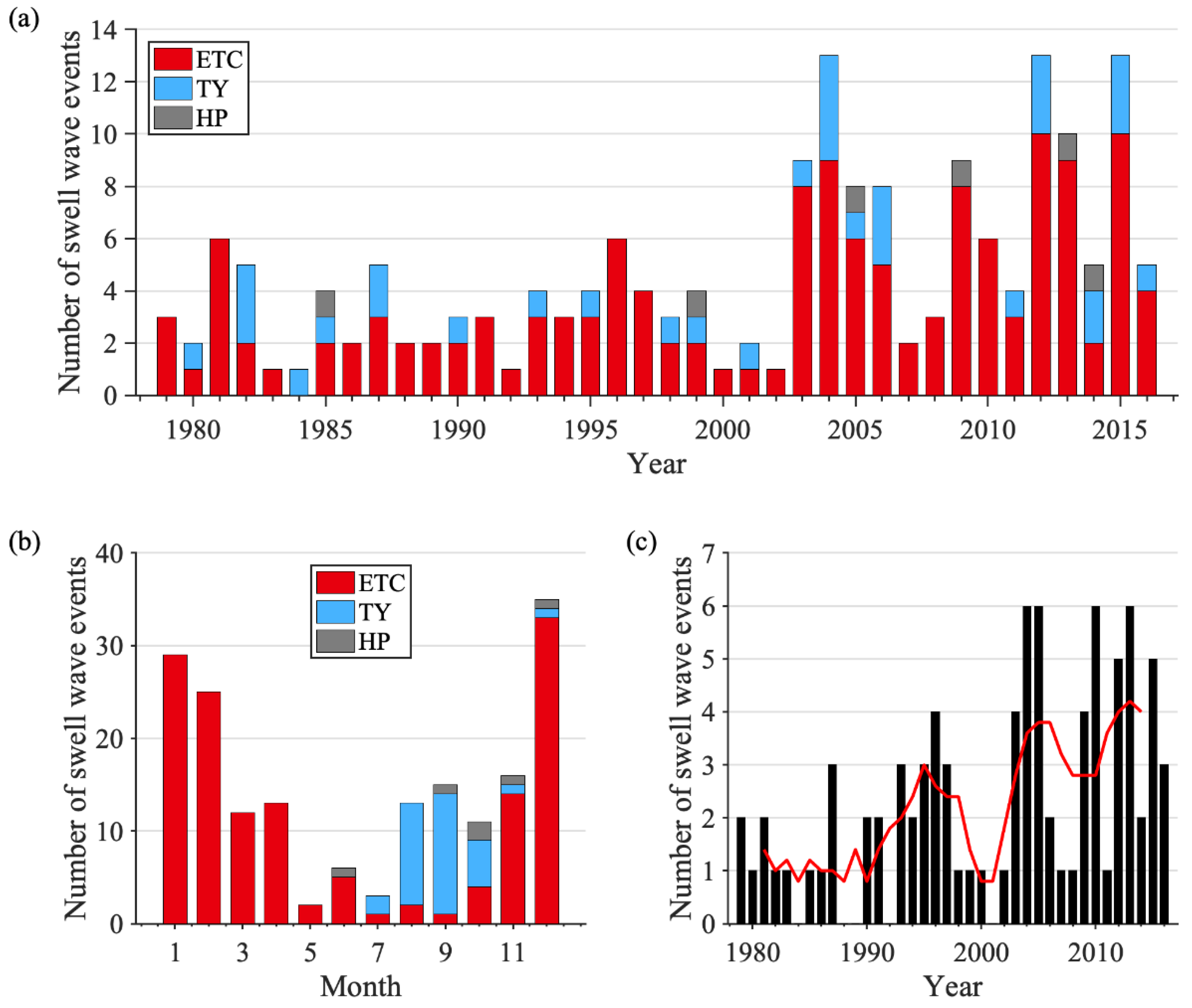
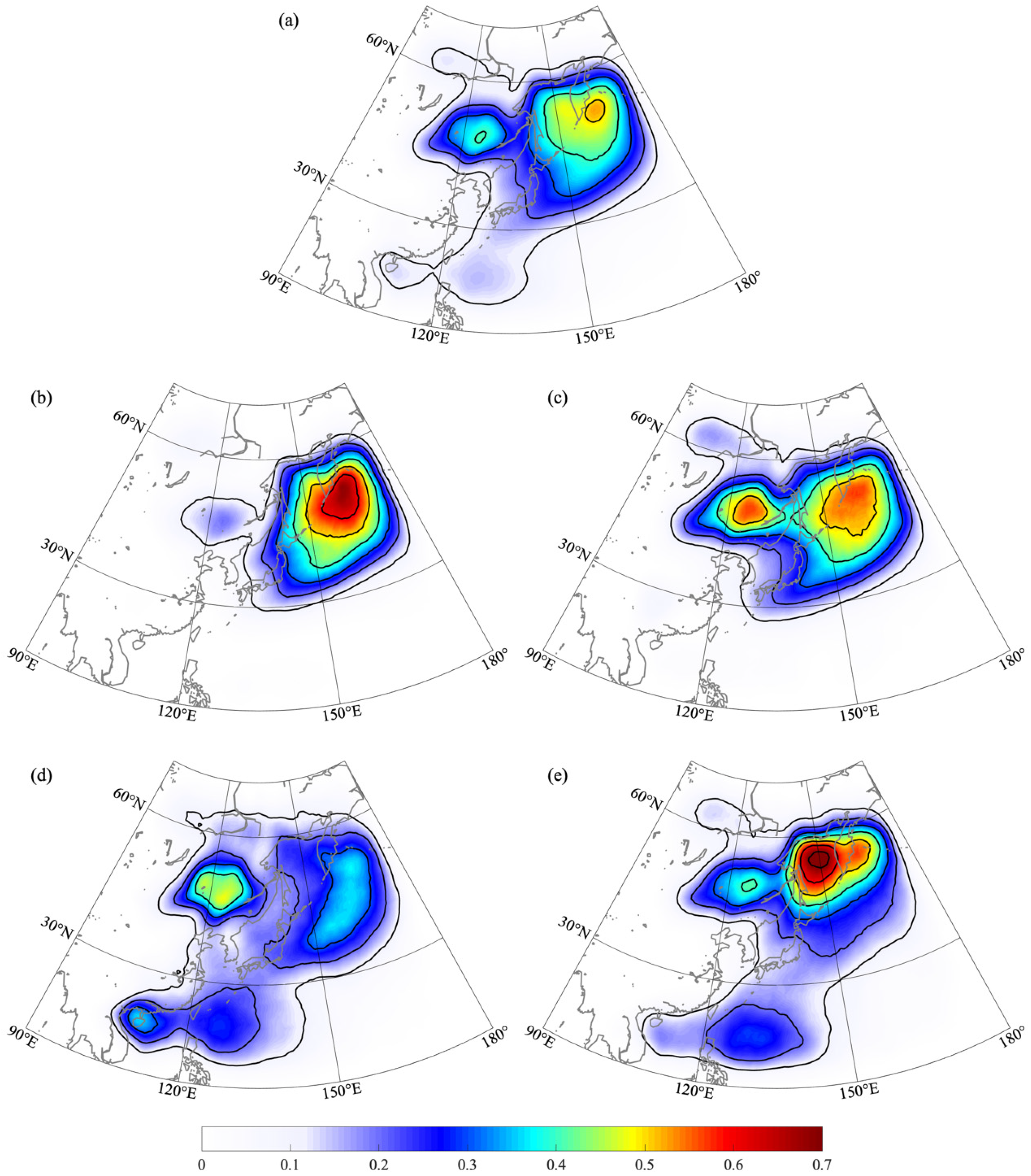



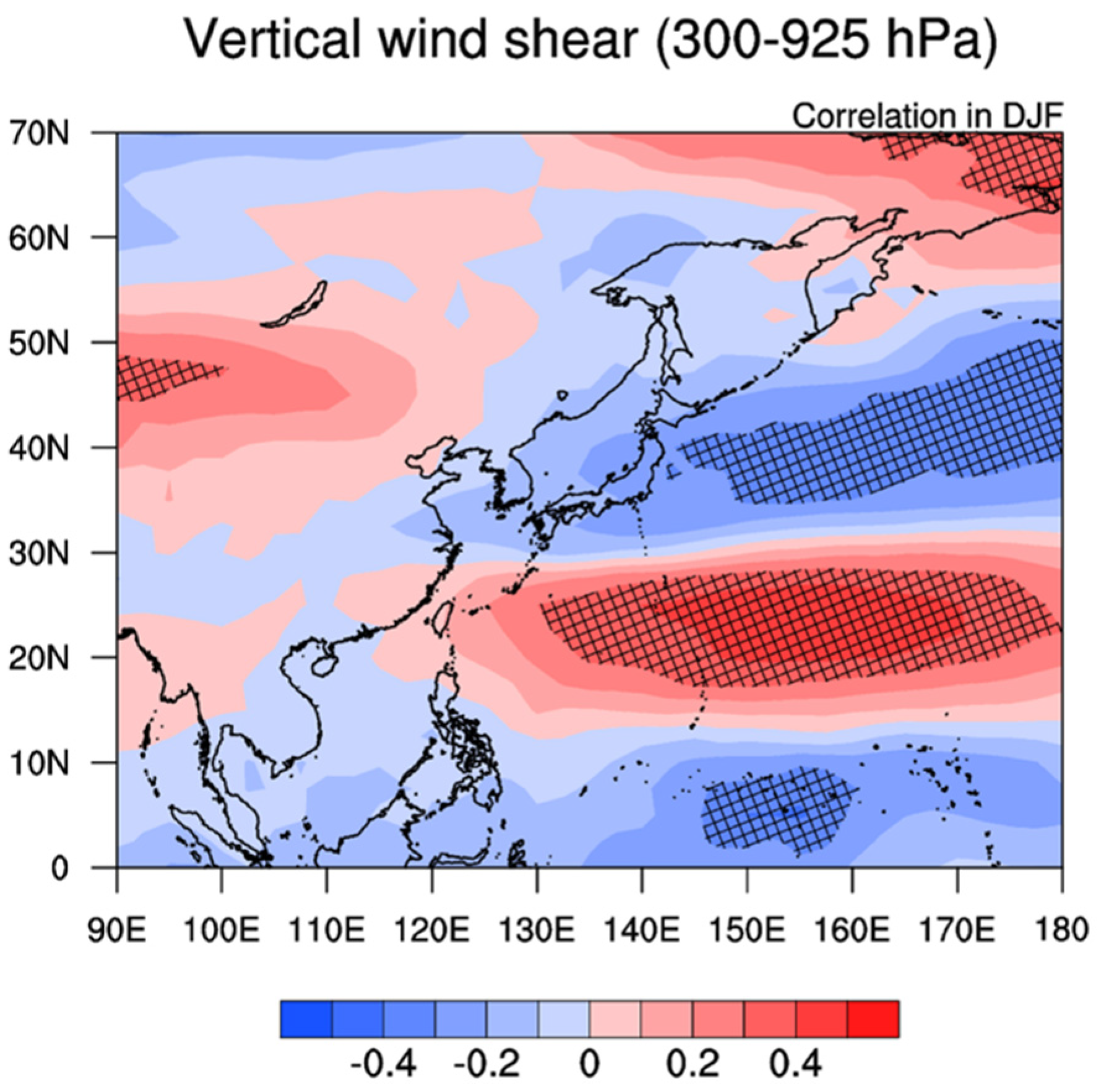
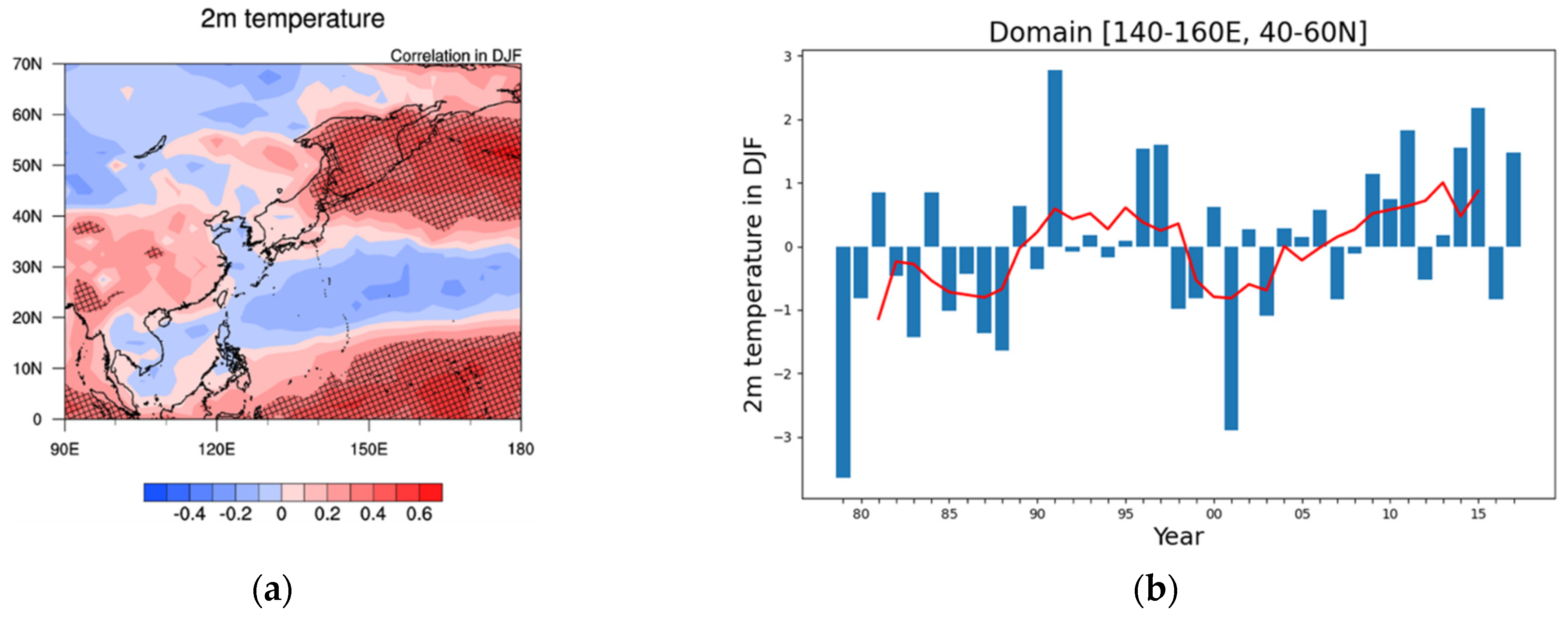
| Name | Organization | Location | Component | Measurement Duration | Water Depth (m) |
|---|---|---|---|---|---|
| Sokcho (SC) | KIOST | 38.20° N, 128.63° E | Current Hm0 T02 Tp | October 2010~December 2016 | 15.0 |
| Maengbang (MB) | KIOST | 37.41° N, 129.22° E | September 2014~December 2016 | 25.9 | |
| Wuljin (WJ) | KIOST | 37.07° N, 129.42° E | September 2014~December 2016 | 18.7 | |
| Hupo (HP) | KIOST | 36.70° N, 129.48° E | December 2011~March 2014 | 17.5 | |
| Youngil (YI) | KIOST | 36.09° N, 129.47° E | August 2010~August 2015 | 24.5 | |
| Sureummal (SR) | KIOST | 35.67° N, 129.48° E | July 2014~December 2016 | 32.1 | |
| Donghae (DH) | KMA | 37.53° N, 130.00° E | Wind SST Hs Tm | January 2005~December 2016 | - |
| Ulleung (UL) | KMA | 37.45° N, 131.10° E | December 2011~December 2016 | - | |
| Pohang (PH) | KMA | 36.35° N, 129.78° E | November 2008~December 2016 | - | |
| Ulleung NE (E01) | KHOA | 38.00° N, 131.54° E | October 2012~December 2016 | - | |
| Ulleung NS (E02) | KHOA | 37.72° N, 130.56° E | August 2014~December 2016 | - |
| Model Used | WRF v.3.7.1 |
|---|---|
| Initial and boundary conditions | ERA-Interim 0.75° × 0.75° (6-h interval) |
| Horizontal and vertical resolution | 10 km × 10 km, 60 layers to 50 hPa |
| Horizontal grid points in X-Y direction | 435 × 435 |
| Period of integration | 30 h (including 6 h spin-up) |
| Cumulus parameterization schemes | Kain–Fritsch scheme |
| PBL parameterization schemes | YSU PBL scheme |
| Microphysics parameterization schemes | WSM 6-class graupel scheme |
| Radiation parameterization scheme | Dudhia short-wave and RRTM long-wave radiation scheme |
| Surface layer scheme | Monin–Obukhov similarity theory |
| Land-surface scheme | Noah land surface scheme |
| Name | MB (m/s) | RMSE (m/s) | IOA | CC Magnitude | CC Phase Lag (Degree) | Num. of Pairs |
|---|---|---|---|---|---|---|
| Donghae (DH) | 0.62 | 2.31 | 0.86 | 0.80 | −11.1 | 15,616 |
| Ulleung (UL) | 0.84 | 2.24 | 0.89 | 0.87 | −5.7 | 16,362 |
| Pohang (PH) | 0.34 | 2.24 | 0.89 | 0.87 | −8.5 | 16,463 |
| Ulleung NE (E01) | 0.23 | 2.01 | 0.91 | 0.81 | −6.5 | 12,983 |
| Ulleung NW (E02) | 0.14 | 2.21 | 0.89 | 0.81 | 2.1 | 14,724 |
| Name | Significant Wave Height (m) | Peak Period (s) | |||||||
|---|---|---|---|---|---|---|---|---|---|
| Mean | MB | RMSE | IOA | Num. of Pairs | MB | RMSE | IOA | Num. of Pairs | |
| Donghae (DH) | 1.26 | −0.13 | 0.42 | 0.94 | 17,021 | - | - | - | - |
| Ulleung (UL) | 1.39 | −0.14 | 0.41 | 0.95 | 16,921 | - | - | - | - |
| Pohang (PH) | 1.19 | −0.11 | 0.40 | 0.94 | 17,068 | - | - | - | - |
| Ulleung NE (E01) | 1.15 | 0.00 | 0.63 | 0.89 | 14,599 | - | - | - | - |
| Ulleung NW (E02) | 1.26 | −0.05 | 0.43 | 0.94 | 15,726 | - | - | - | - |
| Sokcho (SC) | 0.76 | 0.02 | 0.30 | 0.94 | 13,685 | −0.1 | 1.0 | 0.91 | 2497 |
| Maengbang (MB) | 0.86 | −0.13 | 0.33 | 0.93 | 16,922 | −0.2 | 0.9 | 0.92 | 3353 |
| Wuljin (WJ) | 1.03 | −0.12 | 0.33 | 0.92 | 12,587 | −0.2 | 0.9 | 0.93 | 2743 |
| Sureummal (SR) | 0.89 | −0.03 | 0.30 | 0.94 | 4705 | −0.2 | 0.9 | 0.94 | 1132 |
| Youngil (YI) | 0.76 | −0.18 | 0.34 | 0.89 | 16,416 | −0.1 | 0.9 | 0.94 | 2820 |
| Name | Significant Wave Height (m) | Peak Period (s) | |||||||
|---|---|---|---|---|---|---|---|---|---|
| Mean | MB | RMSE | IOA | Num. of Pairs | MB | RMSE | IOA | Num. of Pairs | |
| Donghae (DH) | 3.00 | −0.10 | 0.61 | 0.85 | 1993 | - | - | - | - |
| Ulleung (UL) | 3.09 | −0.25 | 0.60 | 0.86 | 2520 | - | - | - | - |
| Pohang (PH) | 3.01 | −0.27 | 0.59 | 0.84 | 1561 | - | - | - | - |
| Ulleung NE (E01) | 3.09 | −0.13 | 0.58 | 0.88 | 1554 | - | - | - | - |
| Ulleung NW (E02) | 3.07 | −0.09 | 0.53 | 0.89 | 1799 | - | - | - | - |
| Sokcho (SC) | 2.81 | −0.12 | 0.40 | 0.89 | 485 | 0.0 | 0.7 | 0.94 | 485 |
| Maengbang (MB) | 2.81 | −0.19 | 0.44 | 0.86 | 531 | −0.1 | 0.7 | 0.93 | 531 |
| Wuljin (WJ) | 2.90 | −0.35 | 0.62 | 0.65 | 274 | −0.2 | 0.8 | 0.96 | 274 |
| Sureummal (SR) | 2.94 | −0.35 | 0.56 | 0.76 | 266 | −0.1 | 0.8 | 0.91 | 266 |
| Youngil (YI) | 2.71 | −0.20 | 0.50 | 0.80 | 298 | −0.4 | 0.8 | 0.95 | 298 |
Publisher’s Note: MDPI stays neutral with regard to jurisdictional claims in published maps and institutional affiliations. |
© 2022 by the authors. Licensee MDPI, Basel, Switzerland. This article is an open access article distributed under the terms and conditions of the Creative Commons Attribution (CC BY) license (https://creativecommons.org/licenses/by/4.0/).
Share and Cite
Jeong, S.-H.; Heo, K.-Y.; Son, J.-H.; Jo, Y.-H.; Choi, J.-Y.; Kwon, J.-I. Characteristics of Swell-like Waves in the East Coast of Korea Using Atmospheric and Wave Hindcast Data. Atmosphere 2022, 13, 286. https://doi.org/10.3390/atmos13020286
Jeong S-H, Heo K-Y, Son J-H, Jo Y-H, Choi J-Y, Kwon J-I. Characteristics of Swell-like Waves in the East Coast of Korea Using Atmospheric and Wave Hindcast Data. Atmosphere. 2022; 13(2):286. https://doi.org/10.3390/atmos13020286
Chicago/Turabian StyleJeong, Sang-Hun, Ki-Young Heo, Jun-Hyeok Son, Young-Heon Jo, Jin-Yong Choi, and Jae-Il Kwon. 2022. "Characteristics of Swell-like Waves in the East Coast of Korea Using Atmospheric and Wave Hindcast Data" Atmosphere 13, no. 2: 286. https://doi.org/10.3390/atmos13020286
APA StyleJeong, S.-H., Heo, K.-Y., Son, J.-H., Jo, Y.-H., Choi, J.-Y., & Kwon, J.-I. (2022). Characteristics of Swell-like Waves in the East Coast of Korea Using Atmospheric and Wave Hindcast Data. Atmosphere, 13(2), 286. https://doi.org/10.3390/atmos13020286






